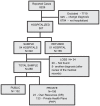Direct costs of dengue hospitalization in Brazil: public and private health care systems and use of WHO guidelines
- PMID: 25188295
- PMCID: PMC4154670
- DOI: 10.1371/journal.pntd.0003104
Direct costs of dengue hospitalization in Brazil: public and private health care systems and use of WHO guidelines
Abstract
Background: Dengue, an arboviral disease, is a public health problem in tropical and subtropical regions worldwide. In Brazil, epidemics have become increasingly important, with increases in the number of hospitalizations and the costs associated with the disease. This study aimed to describe the direct costs of hospitalized dengue cases, the financial impact of admissions and the use of blood products where current protocols for disease management were not followed.
Methods and results: To analyze the direct costs of dengue illness and platelet transfusion in Brazil based on the World Health Organization (WHO) guidelines, we conducted a retrospective cross-sectional census study on hospitalized dengue patients in the public and private Brazilian health systems in Dourados City, Mato Grosso do Sul State, Brazil. The analysis involved cases that occurred from January through December during the 2010 outbreak. In total, we examined 8,226 mandatorily reported suspected dengue cases involving 507 hospitalized patients. The final sample comprised 288 laboratory-confirmed dengue patients, who accounted for 56.8% of all hospitalized cases. The overall cost of the hospitalized dengue cases was US $210,084.30, in 2010, which corresponded to 2.5% of the gross domestic product per capita in Dourados that year. In 35.2% of cases, blood products were used in patients who did not meet the blood transfusion criteria. The overall median hospitalization cost was higher (p = 0.002) in the group that received blood products (US $1,622.40) compared with the group that did not receive blood products (US $550.20).
Conclusion: The comparative costs between the public and the private health systems show that both the hospitalization of and platelet transfusion in patients who do not meet the WHO and Brazilian dengue guidelines increase the direct costs, but not the quality, of health care.
Conflict of interest statement
The authors have declared that no competing interests exist.
Figures
References
-
- Paho (2012) Number of Reported Cases of Dengue and Figures for 2010 (to week noted by each country). Pan American Health Organization
-
- WHO (2009) Dengue: guidelines for diagnosis, treatment, prevention and control. Geneva: Geneva: World Health Organization. 147 p. - PubMed
-
- Suaya JA, Shepard DS, Siqueira JB, Martelli CT, Lum LC, et al. (2009) Cost of dengue cases in eight countries in the Americas and Asia: a prospective study. Am J Trop Med Hyg 80: 846–855. - PubMed
-
- Torres JR, Castro J (2007) The health and economic impact of dengue in Latin America. Cadernos de Saúde Pública 23: S23–S31. - PubMed
Publication types
MeSH terms
LinkOut - more resources
Full Text Sources
Other Literature Sources
Medical



